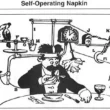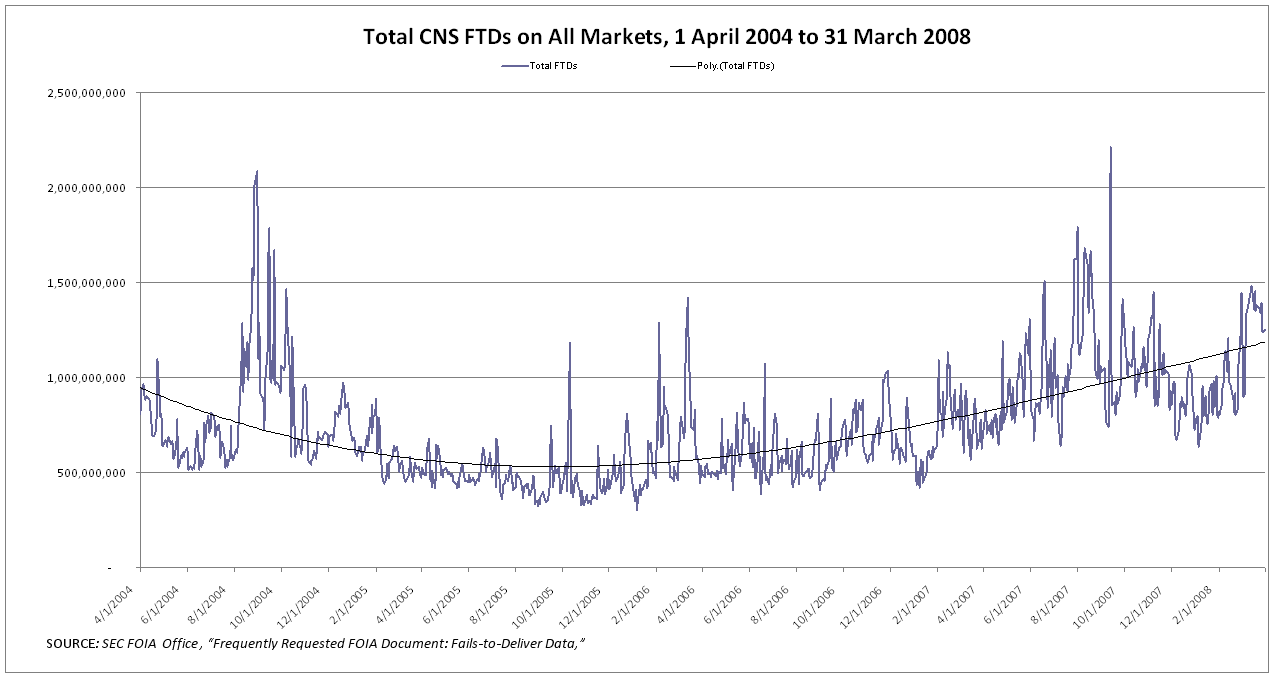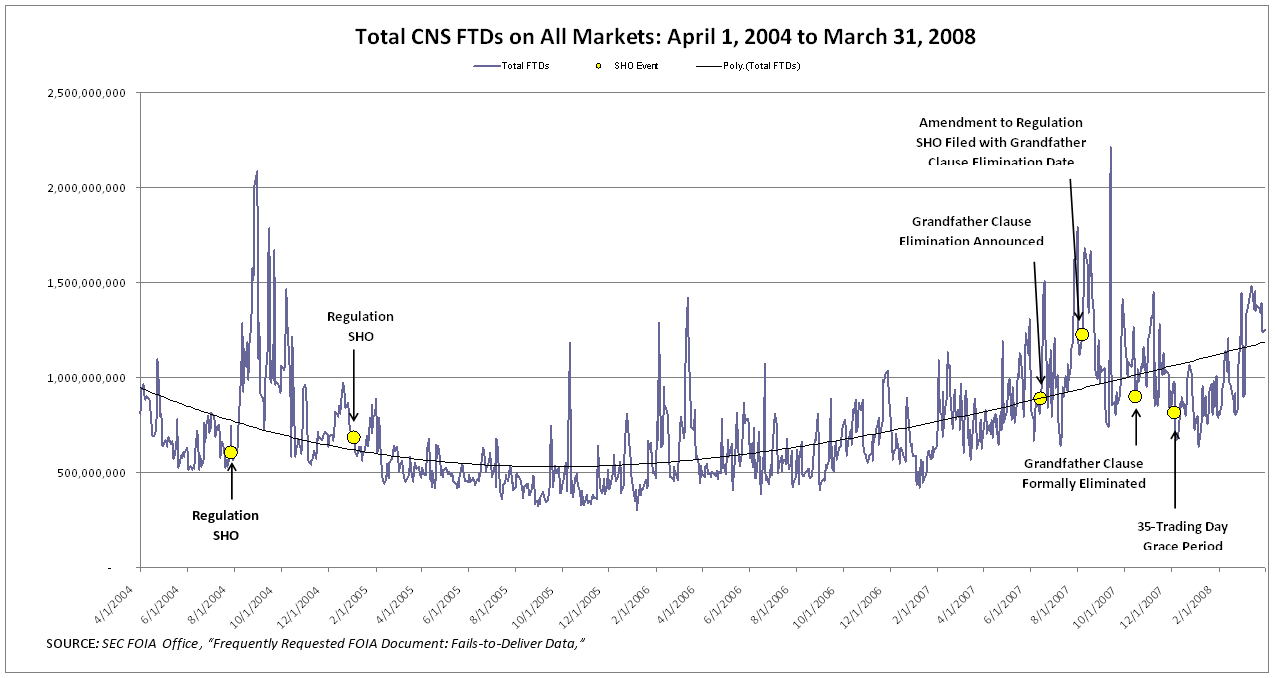In a previous post I named various places where unsettled trades can accumulate: in the desks of brokers, in pre-netting among brokers, in the Continuous Net Settlement (CNS) system, in the Stock Borrow Program (SBP), through ex-clearing, and in delivery mechanisms from offshore exchanges. For all I know, these represent just a subset of the cracks in the system. The great unanswered question is, How much financial toxic waste has naked short selling and its various equivalents left scattered throughout these cracks?
The answer is: I don’t know, and I think no one knows. I suspect no one agent has the full picture of what is going on across all of these cracks. In fact, I suspect some of these cracks are so obscure no one has a clear picture of what is going on in them individually, let alone collectively.
To some degree this is knowable a priori. We have a system that is shielded from scrutiny of every type. State regulators cannot successfully subpoena it (as various state regulators have told me) because the DTCC argues it is shielded by federal regulation. Yet when Feds try to look inside it they are simply rebuffed, and are helpless to assert themselves (as a high-level SEC official told some colleagues of mine). The Feds do not understand it (as a former DTCC employee and various Feds have told me). On those occasions that the Feds do get to look inside the system, they get shined-on (as a former DTCC official tells me and a former SEC official confirms). In fact, four years ago when I began this quest, the first thing I tried to do was to find out who regulated the DTCC, and quickly discovered that, other than a brief mention in an obscure GAO report, even the Feds are not sure if they regulate it. And yet, through this opaque system the treasure of the ages passes every week. Such system-design is a recipe for disaster.
To a lesser degree this is knowable a posteriori, though getting data about the system from the system is an exercise in Kafkaesque futility. There are endless anecdotes of trades that won’t settle, of course. There is also the partial information expressed by the Reg SHO list. There are various FOIA responses which have been pried from the SEC. And for the true aficionados, there are, lately, data files that the SEC periodically releases to the public regarding failures in one of the cracks mentioned, the CNS. Making use of these files is impractical for any members of the general public who do not employ an economist, statistician, and database expert to work the data.
Fortunately, DeepCapture employs an economist, a statistician, and a database expert to work the data. In the following series of posts I am going to reveal their output, stressing again that the failures I will be disclosing are not the totality of failures, but simply a fraction of the total, residing in just one of the cracks (the CNS) into which our federal regulator is permitted to peer.
Here is a chart showing the CNS failures from 2004, the year Reg SHO was adopted, through Q1, 2008:
Here is the same data with some key Reg SHO dates noted:
If this article concerns you, and you wish to help, then:
1) email it to a dozen friends;
2) go here for additional suggestions: “So You Say You Want a Revolution?“






It’s great to put things in clear perspective. Forget the text books on securities markets, this is how the market really works.
We are all obliged to DeepCapture.Com and I’m sure it’ll effect change.
Tom
Thank a ton. This answers so many questions and uses a chart that mom and pop can understand to see how they are being screwed.
Thank you Dr Byrne.
Folks,
You are too kind. There are plenty of folks who should be thanked, but I’m not one of them.
Patrick
Dr Byrne, me and my 3 kids know what self-sacrifice you have done and are doing for this great country. Thank You for carrying the baton to the finish line a winner. This is a MUST for America.
Short selling, selling what you do not own and cannot produce, should be baned totally. The DTCC replacement should be a Treasury Deptartment function that keeps track that all sales are made by the broker holding those shares. Easy to do. At the start each broker tells the number of shares it holds for each stock. Thus for broker designated by A holds shares A1 thru Annn where nnn are the number of shares it holds. When a sale of Annn-Ammm happens the DTCC delets them from broker A inventory and adds them to the buying broker inventory. Any trade of shares not in the selling brokers inventory is invalidated by the DTCC.
This is the only way to eliminate fraud between brokers. Short sales within a broker’s accounts up to its holder OK inventory in margined accounts could still be sold short if law allows.
Dear Dr. Byrne:
Your work to put an end to Naked Short Selling via this blog (DEEP CAPTURE) — and the investigative journalism of Mr. Mark Mitchell, is outstanding — and merits many thanks from any legitimate investor. As mentioned in a video that I saw of yourself, you were mugged in a back alley by these financial criminals, but you and your company are still standing — and you are fighting back. Please keep up the good fight to expose these financial thugs — because many people are hoping beyond hope, for the benefit of us all, that the Naked Short Selling is STOPPED & BANNED as illegal forever.
I just wish that MORE EXPOSURE could put Naked Short Selling in the headlines. I cannot understand why Mainstream Media neglects to perform their ethical watchdog-role — and write about the BLATANT FRAUD being perpetrated by the Naked Short Sellers.
As for CNBC, they only barely mention those tough words for them to verbate on TV — “NAKED SHORT SELLING” — and only late at night in the latest coverage. Why is this? Is it because of their close relations with Hedge Funds — believed to be the primary perpetrators of Naked Short Selling? My nickname for CNBC is the “Hedge Fund Channel” — because it seems that they will report any and all negative news about a failing investment bank (e.g.- Bear Stearns — I clearly remember Mark Faber’s comments made — after speaking to a friend at a Hedge Fund with whom he had known for over 20 years) or a failing auto maker (e.g. – GM — Now, CNBC seems to be ridiculing this struggling automaker, talking publicly about what kind of vehicle the CEO will drive to the Congressional Hearing). Is it a coincidence that Bear Stearns and GM were being SHORTED like crazy by Hedge Funds at the time of CNBC’s reports? It seems that CNBC just has so much in common with Hedge Funds — almost incestuous.
By publicizing this mess of corruption, investigative journalists in Mainstream Media could join Dr. Byrne, Mr. Mitchell and others — to try and put an end to Naked Short Selling. The financial rapists, like any other common criminal perpetrator, will continue — and the damage could pose those 2 words that should be directly correlated to Naked Short Selling: SYSTEMIC RISK.
Unfortunately, the neglect of not cracking-down on corruption could pose 2 new words: SYSTEMIC COLLAPSE. This brings me to the man where the buck stops — or, in this case, the Naked Short Selling could stop.
It seems that many of the problems surrounding Naked Short Selling could be remedied quickly by SEC Chairman Christopher Cox. In my view, the responsibility to put an end to the financial rape of stock equities via Hedge Fund Bear Raids is with the office of Chairman of the SEC.
With the above said, is not high-time to create a PETITION OF TERMINATION for SEC Chairman Christopher Cox?
I know the new administration is just around the corner, and a new SEC Chairman could be appointed. But, ethical responsibility compels me to write this request — that a Petition for Termination of SEC Chairman Cox — be slapped down on the desk in front of him before he leaves. Why? Isn’t every day precious at this juncture? The worse it gets — the more of a chance of total SYSTEMIC COLLAPSE, correct?
I believe action should be taken to terminate Cox ASAP. If nothing else happens, then at least publicity would be garnered.
Thanks again Dr. Byrne for your outstanding work done to stop Naked Short Selling. And – to anyone that reads this, let’s all keep on keep trying to expose this fraud, and hopefully, we will all see justice soon!
Hang_’em_High
Dr. Byrne, i have been a trader for years in the equity markets and have to thank you. We do not want shorting banned just we want the shorts to borrow the shares correctly and put the dtc in its place, i cant believe no govt. entity sees this , it is as black and white. thank you again for trying to help our great nation. Please do not stop… our prayers are with you as your are battling the worst evil created.
Does the FICC have a settlement system similar to the DTCC’s CNS that “nets” trades in Treasury Securities to allow the masking of FTD’s? Or do they have a different/ more accountable system? If not I imagine that FTD’s could also become a huge systemic liability to the the government securities market.
First a big thank you to Dr. Byrne and Mr. Mitchell and anyone else who is trying to expose this crime.
I check this site regularly and was reading some of the recent comments by kd suggesting creating an ‘open source real-time exchange’. I’m not sure that the open source community could produce such a beast and if they could, how would it be accepted for use by the parties involved?
I do think that a real-time settlement system would be a good thing. If you search for ‘real-time settlement system’ you will find that other countries already have such systems in place at least for certain markets. One interesting tidbit I came across was this PDF http://www.sec.gov/rules/concept/s71304/jjangel04092004.pdf on the SEC website which is a letter dated April 9, 2004 from a Dr. James Angel to SEC Secretary Jonathan Katz in which Dr. Angel gives a good reasoning as to why RTSS should be implemented. And that was way back in 2004! I’m not sure I or anyone here would agree with Dr. Angel’s position on short selling though…
An RTSS should eliminate failures to deliver. By their nature, an RTSS must be basically all digital which should also allow for a huge window for transparency and oversight.
I think implementing an RTSS is such a huge task that it would only be accomplished and accepted through a federal program and/or mandate.
I also think RTSSs should be imposed on all markets possible (stock markets, commodities markets, futures markets, etc.).
In the meantime I would argue that the uptick rule must be reinstated and they should probably also tack on a hard borrow measure on top of that.
Anyway, keep up the good work. It is appreciated. I look forward to the day when I can invest in a transparent and honest market. Thanks!
Thanks, you guys. Y’all and Harry Marcopolos, dunno what we’d do without folks like y’all —